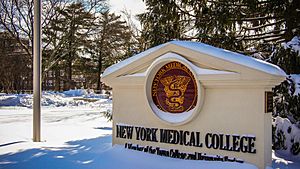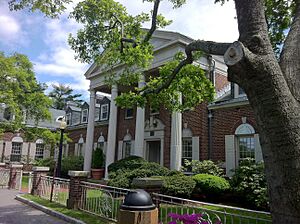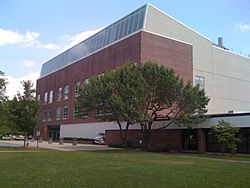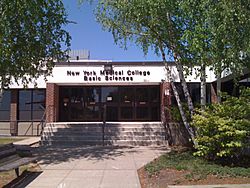New York Medical College facts for kids
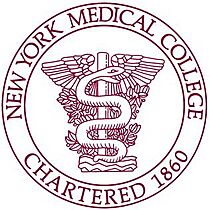 |
|
| Type | Private medical school |
|---|---|
| Established | 1860 |
|
Parent institution
|
Touro College and University System |
| Endowment | $68.8 million (2020) |
| Chancellor | Edward C. Halperin |
| President | Alan Kadish |
|
Academic staff
|
131 FT/ 181 PT (2023) |
| Students | 1,470 (800 medical) |
| Location |
,
,
United States
41°05′06″N 73°48′36″W / 41.085017°N 73.810041°W |
| Colors | Maroon, ochre |
New York Medical College (also known as NYMC or New York Med) is a private school in Valhalla, New York, where students learn to become doctors and other health experts. Founded in 1860, it is one of the oldest medical schools in the United States. Today, it is part of the Touro University System.
NYMC has three main schools: the School of Medicine, the Graduate School of Biomedical Sciences, and the School of Health Sciences and Practice. Over 1,600 students attend the college. They learn from more than 1,300 teachers and professors.
The college is on a large 600-acre campus that it shares with Westchester Medical Center and the Maria Fareri Children's Hospital. This means students can learn in a real hospital setting. NYMC also has a very old partnership with Metropolitan Hospital Center in Manhattan, which started in 1875. This is the oldest partnership between a private medical school and a public hospital in the country.
Contents
History of the College
Early Days
New York Medical College was started in 1860 by a group of leaders in New York City. One of the main leaders was the famous poet William Cullen Bryant. He was worried about the hospitals and medical treatments of that time. He wanted to create a school that focused more on what patients needed to get better.
The school first opened as the Homeopathic Medical College of the State of New York. At the time, "homeopathic" medicine was a different approach to healing. The school's first class had 59 students and 8 professors.
A few years later, in 1863, a separate college for women was founded, called the New York Medical College and Hospital for Women. This was very important because it gave women a chance to become doctors.
- In 1867, Emily Stowe graduated and became the first female doctor to practice in Canada.
- In 1870, Susan McKinney Steward graduated, becoming the first African-American female doctor in New York State.
When the women's college closed in 1918, its students moved to New York Medical College.
Growing and Changing
In 1889, the college built the Flower Free Surgical Hospital. This was the first teaching hospital in the U.S. to be owned by a medical college. A teaching hospital is a hospital where student doctors learn by working with experienced doctors.
The college moved to its current home in Valhalla, New York, in 1972. This allowed it to work closely with the new Westchester Medical Center. For many years, the college was supported by the Roman Catholic Archdiocese of New York.
In 2011, the college became part of the Touro University System, which is a Jewish-sponsored organization. This makes NYMC special because it has been a non-religious school, a Catholic-sponsored school, and now a Jewish-sponsored school.
Fun and Interesting Facts
In 2016, the college restored some fun statues along a campus walkway. The statues are believed to be characters from the book Alice's Adventures in Wonderland. They were originally part of a children's hospital wing to help cheer up sick kids.
In 2017, NYMC opened a special center to help first responders. This center trains people to handle emergencies like natural disasters or terrorist attacks. It helps them learn the best ways to save lives in difficult situations.
Schools at NYMC
New York Medical College is made up of three different schools, each with a special focus.
School of Medicine (SOM)
This is the main school for students who want to become doctors and earn a M.D. degree. It is one of the oldest medical schools in the country. About 800 students are enrolled here. To get into this school, students need very good grades and high scores on a special test called the MCAT.
Students at the School of Medicine learn about the human body, diseases, and how to treat patients. They also get to work in real hospitals to practice what they have learned.
Graduate School of Biomedical Sciences (GSBMS)
This school is for students who want to become scientists. Instead of treating patients, these students do research in laboratories. They work to understand diseases and discover new ways to fight them. They can earn advanced degrees like a Master of Science or a Ph.D..
School of Health Sciences and Practice (SHSP)
This school trains students for other important jobs in healthcare. For example, students can learn to become physical therapists, who help people recover from injuries. They can also study public health, which focuses on keeping whole communities healthy. Or they can become speech-language pathologists, who help people with speaking and communication problems.
Hospitals Where Students Learn
A big part of learning to be a doctor is working in a real hospital. NYMC is connected with over 20 hospitals in New York, New Jersey, Connecticut, and West Virginia. These are called affiliated hospitals. This gives students a chance to see many different kinds of patients and medical situations.
The two main hospitals are:
- Westchester Medical Center: This hospital is right on the same campus as the college in Valhalla. It is the college's main teaching hospital.
- Metropolitan Hospital Center: This hospital is in Manhattan. NYMC has worked with this hospital since 1875, making it a very important partner.
Students may live on campus in Valhalla or in housing provided by the college near the hospitals where they are training.
Famous Graduates
Many graduates of New York Medical College have gone on to do amazing things. Here are a few of them:
- Susan McKinney Steward: The first African-American woman to become a doctor in New York State. She graduated in 1870.
- William Harkness: An astronomer who became a Rear Admiral in the United States Navy and directed the United States Naval Observatory.
- Harry J. Buncke: A surgeon known as "The Father of Microsurgery." Microsurgery is a type of surgery that uses microscopes to work on very small parts of the body, like tiny blood vessels.
- Liz Jaffee: A cancer researcher at Johns Hopkins University. In 2012, President Barack Obama chose her to be on the National Cancer Advisory Board.
- William Anthony Paddon: A doctor who served in the Royal Canadian Navy during World War II. He later became the Lieutenant-Governor of Newfoundland and Labrador in Canada.
Images for kids


